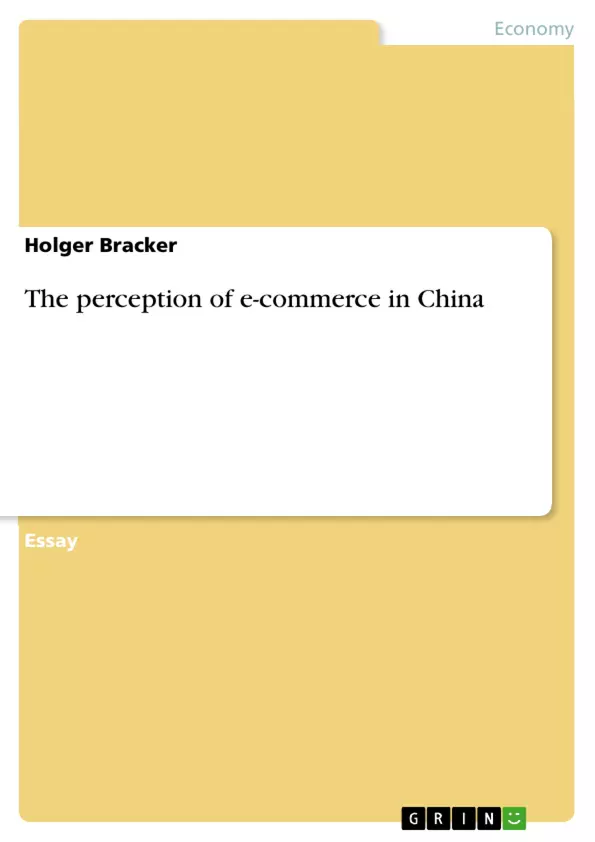During the last decade Internet usage has experienced a tremendous increase in the Asian region and especially in China. According to Internet World Stats (2010) the number of internet users in Asia from 2000 to 2010 increased from 114.3 million to 825.1 million (721.8%). In the same time period China's number of Internet users increased from 22.5 million in December 2000 to approximately 420 million by June 2010 representing an increase of more than 1,800% (see table 1). Full-functional internet connection for private households in China, for example, was first established on 20 April 1994 (China Internet Network Information Center (CNNIC), 2010) and was followed by steady growth.
Inhaltsverzeichnis (Table of Contents)
- Introduction - Internet in Asia and how it developed
- Regulations in e-commerce across Asia
- Online B2C relationship and the perception of e-commerce
- Influential factors of perception of e-commerce
- Distinguishing perceptions in rural and urban areas
- Internet consumption vs. government regulations...
- Conclusion.........
Zielsetzung und Themenschwerpunkte (Objectives and Key Themes)
This essay analyzes the perception of online businesses in China with a focus on business to consumer relationships. It explores the role of cultural values and government regulation in shaping consumer behavior towards e-commerce in the Asian context.
- The development and growth of internet usage in Asia, particularly in China.
- The regulatory framework for e-commerce in Asia and the challenges of balancing liberalization with government control.
- The factors influencing consumer perceptions of e-commerce, including trust, perceived ease of use, and cultural values.
- The differences in internet usage and e-commerce adoption between urban and rural areas in China.
- The role of traditional business practices and cultural values in shaping consumer trust and online purchase behavior.
Zusammenfassung der Kapitel (Chapter Summaries)
- Introduction - Internet in Asia and how it developed: This chapter provides an overview of the rapid growth of internet usage in Asia, particularly in China, highlighting the opportunities for businesses in this emerging market. The chapter also introduces the focus of the essay: analyzing the perception of e-commerce and its impact on business-to-consumer relationships.
- Regulations in e-commerce across Asia: This chapter defines e-commerce and explores its various categories, focusing on the business-to-consumer (B2C) model. It discusses the WTO's push for e-commerce liberalization in member countries, emphasizing the challenges of balancing liberalization with the need for protective measures. The chapter highlights the difficulties faced by countries like China in liberalizing trade while maintaining government control, leading to strict regulations and potential privacy concerns.
- Online B2C relationship and the perception of e-commerce: This chapter explores the perception of e-commerce in China, comparing it to traditional business practices. It discusses the challenges of establishing trust in online relationships and the importance of face-to-face interactions in building customer relationships. The chapter also examines the role of cultural values in shaping consumer behavior towards online purchases.
- Influential factors of perception of e-commerce: This chapter investigates the factors influencing consumer perceptions of e-commerce, drawing on Yoon's research on the effects of national culture values. The chapter explores the concept of trust in online transactions and its relation to cultural values such as power distance, individualism, and uncertainty avoidance. It highlights the potential challenges posed by these cultural factors in building trust in online business relationships.
- Distinguishing perceptions in rural and urban areas: This chapter emphasizes the differences in internet usage and e-commerce adoption between urban and rural areas in China. It discusses the factors contributing to higher internet penetration in urban areas, including exposure to Western cultures and greater access to broadband connections. The chapter also explores the potential impact of cultural differences on traditional buying behavior in rural areas.
Schlüsselwörter (Keywords)
The key concepts and themes explored in this essay include e-commerce, B2C relationships, cultural values, government regulation, trust, perception, consumer behavior, internet usage, online shopping, urban-rural divide, and the Chinese market.
- Quote paper
- Holger Bracker (Author), 2010, The perception of e-commerce in China, Munich, GRIN Verlag, https://www.grin.com/document/172007



